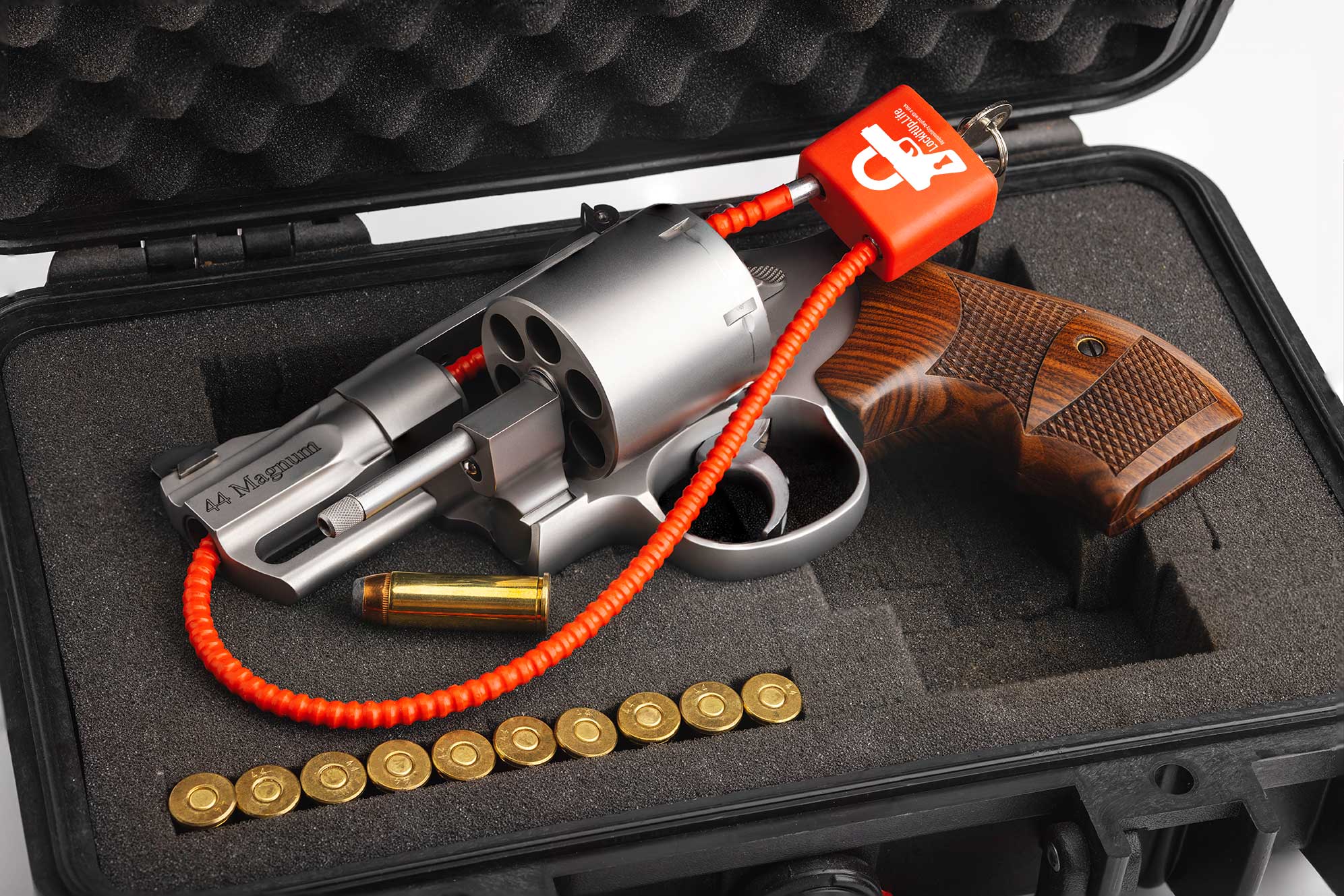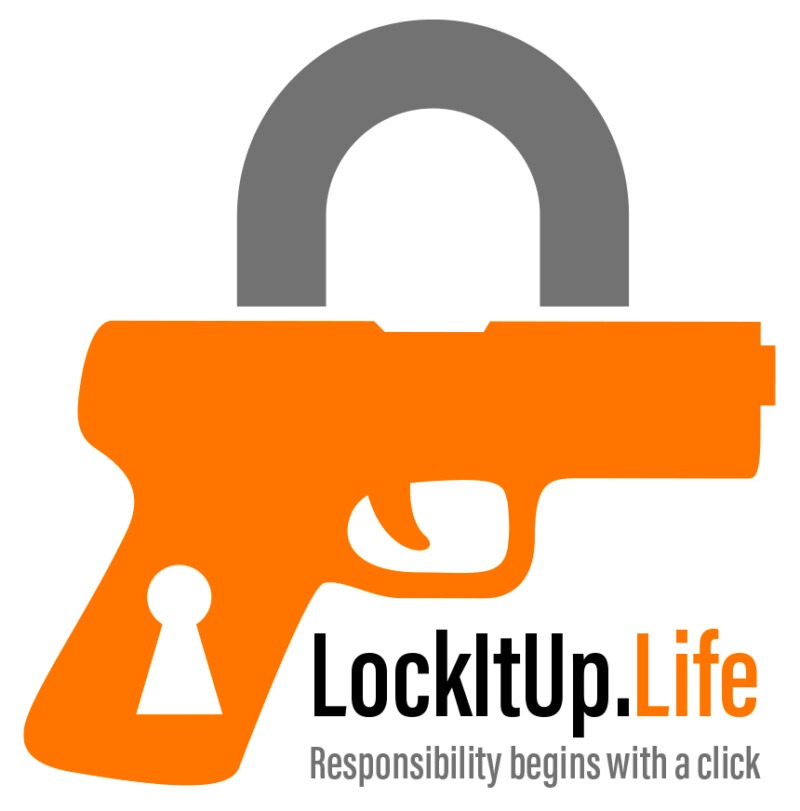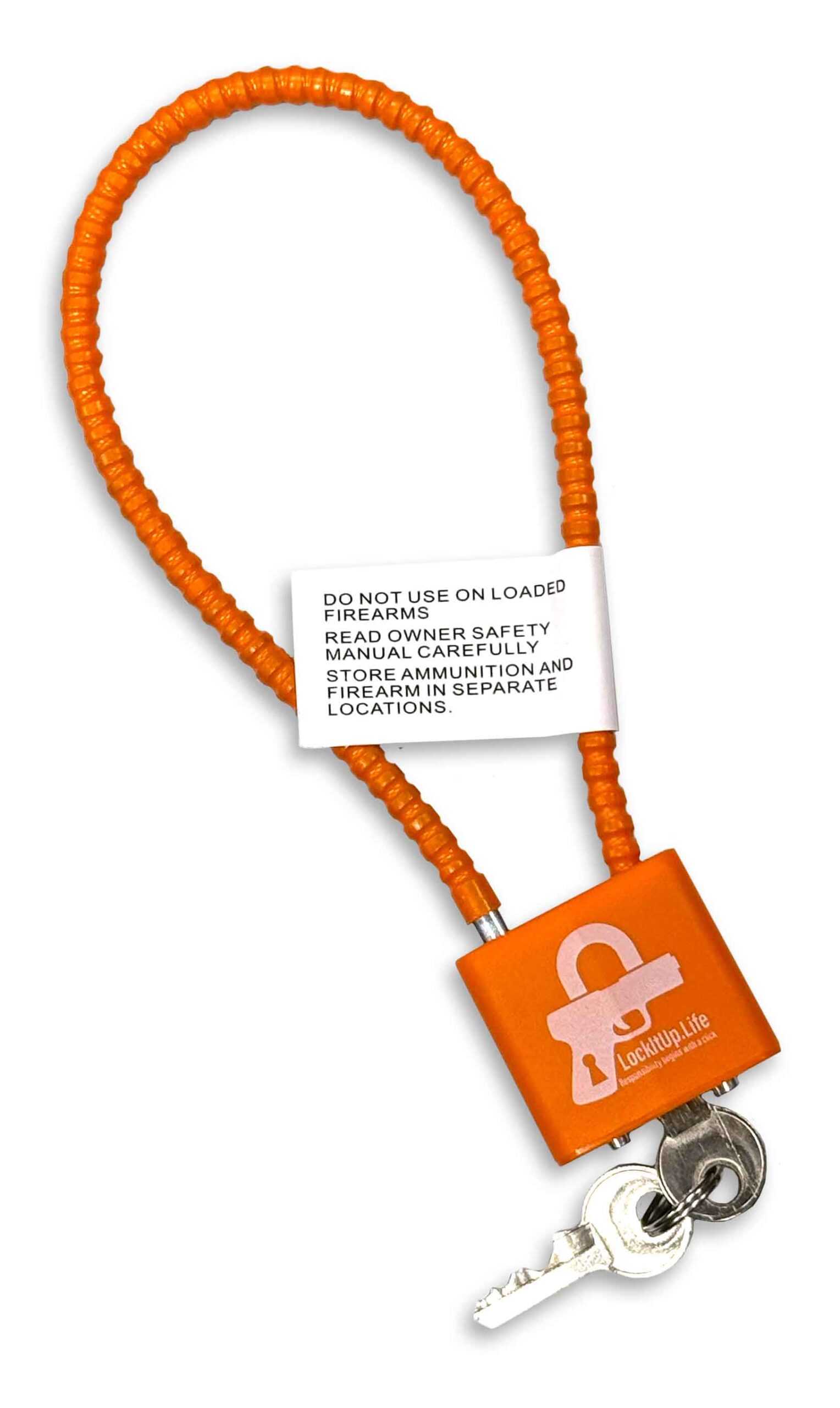LockItUp.Life began as a shared commitment between Gun For Hire and Mike Candido, President of J. Moore & Co. Mechanical Contractors, to make firearm safety simple, accessible, and free for everyone. What started as a local initiative has grown into a community-driven effort to promote responsible gun ownership and prevent unauthorized use of firearms.
At LockItUp.Life, we’re committed to protecting you, your loved ones, and your community. 100% of your donation goes toward purchasing cable-style gun locks, which we donate to hospitals so they can provide them—free of charge—to anyone who needs one. Every contribution turns into a lock in the right hands, and every lock has the power to save lives.
A cable lock is a small, effective tool that can make a big difference in preventing accidents or misuse. If you’re new to firearm safety or unsure how to secure your gun, we’re here to guide you step-by-step. You don’t have to figure it out alone—your safety is our priority.
Let’s lock it up together. Donate today, and help us protect lives—one lock at a time.
At LockItUp.Life, we’re committed to promoting responsible firearm ownership and ensuring the safety of you, your loved ones, and your community. A cable-style gun lock is a simple, effective tool to prevent unauthorized use of your firearm. Follow these step-by-step instructions to properly install and use your cable lock.
A Message for Those New to Firearm Safety
At LockItUp.Life, we understand that not everyone feels confident handling or securing a firearm—and that’s okay. Whether you’re new to gun ownership, unfamiliar with locking devices, or simply unsure about the process, you don’t have to figure it out alone. Your safety, and the safety of those around you, is our priority.
If operating or locking up your firearm feels overwhelming, we encourage you to seek assistance and education. You’re not alone in this—many people benefit from a little guidance to get comfortable with the steps. Here’s how you can get started:
- Ask a Trusted Expert: Reach out to a friend, family member, or gun owner you trust who can walk you through unloading and locking your firearm safely.
- Take a Safety Course: Local ranges, law enforcement agencies, or community programs often offer beginner-friendly firearm safety classes that cover locking techniques.
- Contact LockItUp.Life Support: We’re here to help. Emil info@LockItUp.Life for resources, step-by-step guides, or to connect with a safety educator near you.
There’s no shame in asking for help—it’s a sign of responsibility. Learning how to properly secure your firearm with a cable lock is a simple, empowering step toward protecting yourself and your loved ones. Let’s lock it up together, safely and confidently.
Before You Begin
• Safety First: Always treat every firearm as if it’s loaded, even when you know it isn’t. Never point it at anyone, and keep your finger off the trigger at all times.
• Unload Your Firearm: Remove all ammunition from the firearm. Take out the magazine (if applicable), and double-check that the chamber is empty.
• Engage the Safety: If your firearm has a safety mechanism, switch it to the “on” position for added protection.
• Work in a Safe Space: Ensure children or unauthorized individuals cannot access the area where you’re installing the lock.
Installation Instructions
Your LockItUp.Life cable lock kit includes a reinforced steel cable and a keyed padlock. Here’s how to install it on different types of firearms:
For Pistols (Semi-Automatic)
- Open the Action: Pull back the slide and engage the slide lock to keep the chamber open.
- Thread the Cable: Insert the end of the cable through the ejection port (where spent casings exit) and guide it down through the empty magazine well.
- Secure the Lock: Gently release the slide forward so it rests against the cable. Attach the cable end to the padlock, insert the key, and turn it clockwise to lock. Tug lightly to ensure it’s secure.
- Remove the Key: Take the key out and store it separately (see Storage Tips below).
For Rifles and Shotguns
- Open the Action: If possible, lock the bolt or action open. For pump-action shotguns, slide the pump back.
- Thread the Cable: Feed the cable through the ejection port and out through the loading port or magazine well.
- Secure the Lock: Gently close the action against the cable. Connect the cable end to the padlock, lock it with the key, and test its security with a light tug.
- Remove the Key: Store the key in a separate, safe location.
For Revolvers
- Open the Cylinder: Swing out the cylinder to expose the chambers.
- Thread the Cable: If the barrel is wide enough, thread the cable through the barrel from the muzzle end, exiting near the cylinder. If not, pass the cable through two empty chambers in the cylinder.
- Secure the Lock: Close the cylinder (if possible) and attach the cable to the padlock. Lock it with the key and confirm it’s secure.
- Remove the Key: Keep the key in a separate, inaccessible spot.
New Jersey State Law requires that all firearms must be stored, unloaded, in a securely locked gun safe or locked container, and all ammunition must be stored separately from the firearm. Bill 2783
How to Use Your Cable Lock
- Purpose: The cable lock prevents the firearm from being loaded or fired by blocking key components like the chamber, barrel, or action.
- Locking: After threading the cable as described, always ensure the padlock is fully engaged. A locked firearm cannot function until the cable is removed.
- Unlocking: To use your firearm, retrieve the key, insert it into the padlock, turn counterclockwise to unlock, and carefully remove the cable. Check that the firearm remains unloaded before proceeding.
- Storage: When not in use, store your locked firearm in a secure location, such as a gun safe or lockbox, away from children and unauthorized users.
Storage Tips
- Separate Key Storage: Store the key in a different location from your firearm and ammunition—ideally in a locked container or hidden spot only you can access.
- Ammunition: Keep ammunition in a separate, locked container to add an extra layer of safety.
- Visibility: Avoid leaving your firearm in plain sight, even when locked. Use a case or safe for added protection.
Important Notes
- Check Compatibility: Not all cable locks fit every firearm. Refer to your firearm’s manual or contact LockItUp.Life support if you’re unsure.
- Do Not Force: If the cable doesn’t thread easily, stop and reassess—forcing it could damage your firearm or the lock.
- Regular Inspection: Periodically check your cable lock for wear, rust, or damage. Replace it if compromised.
By using your LockItUp.Life cable lock correctly, you’re taking a vital step toward preventing accidents and ensuring firearm safety. For additional resources or questions, contact the LockItUp.Life Safety Program at info@LockItUp.life

Top 10 Tips on Handling Firearms Safely
A Checklist for Responsibility
Use this checklist to ensure you’re handling your firearm safely every time. Cross off each step as you make it part of your routine—your safety depends on it.
- 1. Treat Every Firearm as Loaded
Always assume a firearm is ready to fire, even if you think it’s unloaded. - 2. Keep Your Finger Off the Trigger
Rest your finger outside the trigger guard until you’re ready to shoot. - 3. Point in a Safe Direction
Never aim at anything you don’t intend to shoot—keep the muzzle pointed away from people and objects. - 4. Unload Before Handling
Remove all ammunition and confirm the chamber and magazine are empty before cleaning, locking, or storing. - 5. Know Your Target and Beyond
Be aware of what’s in front of and behind your target to avoid unintended harm. - 6. Store Securely When Not in Use
Lock your firearm with your Gun LOCKE cable lock and store it out of reach of unauthorized individuals. - 7. Use Proper Ammunition
Only load ammunition that matches your firearm’s specifications—check the manual or barrel markings. - 8. Wear Eye and Ear Protection
Protect yourself with safety glasses and earplugs or muffs when firing at a range. - 9. Avoid Drugs and Alcohol
Never handle a firearm if you’ve consumed alcohol or impairing substances—stay sharp and focused. - 10. Educate Yourself Regularly
Take a safety course or review guidelines annually to keep your skills and knowledge current.
Top 10 Checklist for Storing Firearms Safely
Secure Your Firearm, Protect Your Peace of Mind
Proper storage is the cornerstone of firearm safety. Use this checklist to ensure your firearm is stored securely every time. Cross off each step as you implement it—consistency saves lives.
- 1. Unload Before Storing
Always remove all ammunition from the firearm. For example, with a handgun, eject the magazine and clear the chamber before locking it up. - 2. Use a Cable Lock
Secure the firearm with a Gun LOCKE cable lock. Thread the cable through the barrel or action (e.g., through a revolver’s cylinder or a rifle’s ejection port) and lock it with the padlock to prevent use. - 3. Store in a Safe
Place your locked firearm in a safe. For instance, a tall floor safe can hold multiple rifles and handguns, keeping them upright and organized behind a combination or key lock. - 4. Opt for a Smaller Desktop Safe
For quick access with security, use a smaller desktop safe. Example: Store a single pistol with its cable lock inside a biometric desktop safe on your nightstand, ensuring it’s locked and out of reach. - 5. Separate Ammunition
Keep ammo in a different locked location. For example, store bullets in a separate drawer with a padlock or in a small ammo box inside a tall floor safe, away from the firearm compartment. - 6. Hide the Key or Code
Store your cable lock key or safe combination securely. Example: Keep the key in a locked jewelry box or memorize the code for a tall floor safe instead of writing it near the safe. - 7. Anchor Large Safes
Bolt tall floor safes to the ground or wall. For instance, secure a 5-foot gun safe to your closet floor with anchor bolts to prevent tipping or theft. - 8. Limit Access
Ensure only authorized users can reach the firearm. Example: A smaller desktop safe with a fingerprint scanner restricts access to you, while a cable-locked rifle in a tall safe keeps it from curious hands. - 9. Check Locks Regularly
Inspect your storage devices for wear. For example, test the cable lock’s padlock monthly for rust, or ensure the hinges on a tall floor safe aren’t loose—replace anything compromised. - 10. Educate Your Household
Teach family members about storage safety without revealing access details. For instance, explain that the handgun in the desktop safe or the rifles in the tall floor safe are off-limits, reinforcing a “locked is safe” mindset.
Top 10 Checklist for Parents: Talking to Curious Kids About Firearm Safety
A Message from LockItUp.Life to Keep Your Family Safe
Children are naturally curious, and firearms can seem exciting or mysterious to them—especially if they see them in movies, games, or around the home. Without proper guidance, that curiosity could lead them to touch or play with a gun they find, putting everyone at risk. Use this checklist to talk to your kids about firearm safety in a clear, age-appropriate way. Cross off each step as you complete it to ensure they understand and respect the rules.
1. Start Early and Keep It Simple
Begin the conversation as soon as they’re old enough to understand (e.g., age 3-5). Say, “Guns are not toys—they’re dangerous tools only adults can use.” Use examples like, “It’s like a hot stove—you don’t touch it because it can hurt you.”
2. Explain the Danger, Not the Fun
Focus on the serious consequences, not the excitement. Tell them, “A gun can hurt or kill someone by accident, even if you’re just pretending.” Avoid glorifying guns—keep the tone firm, like, “This isn’t a game; it’s real life.”
3. Teach the ‘Stop and Tell’ Rule
Instruct them: “If you see a gun anywhere—at home, a friend’s house, or outside—stop, don’t touch it, and tell an adult right away.” Practice it with them: “What do you do if you find a gun under a couch?” (Answer: “Stop, leave it, tell you.”)
4. Show Them It’s Locked
Let them see your firearm secured with a LockItUp.Life cable lock or in a safe. Say, “See how it’s locked? That’s because only grown-ups with the key can use it.” Example: Show the padlock on the cable and explain, “No one can shoot it like this.”
5. Bust the Myths
Address what they see in media. Say, “In video games or movies, guns look cool, but real guns don’t work that way—they don’t have ‘reset’ buttons.” Ask, “What happens in a game if you shoot?” then contrast it with, “In real life, that can’t be undone.”
6. Role-Play Scenarios
Practice what to do if they find a gun. Example: “Pretend you’re at a friend’s house and see a gun on a table—what do you do?” Guide them to say, “I don’t touch it, I leave, and I tell an adult.” Reward them for getting it right!
7. Set Clear Rules and Consequences
Establish a firm boundary: “You never touch a gun, even if you think it’s fake. If you break this rule, [e.g., you’ll lose screen time for a month].” Make it clear this is non-negotiable, like crossing the street without looking.
8. Encourage Questions
Invite them to ask you anything about guns. Say, “If you’re curious, talk to me—I’ll explain it safely.” Example: If they ask, “What does it do?” respond, “It’s a tool for adults, but it’s locked up so no one gets hurt.”
9. Reinforce Adult Responsibility
Emphasize that guns are for grown-ups only. Tell them, “Kids don’t handle guns—just like you don’t drive a car or use the oven alone.” Example: “My job is to keep it locked; your job is to stay safe and tell me if you see one.”
10. Check In Regularly
Revisit the talk as they grow (e.g., every 6 months or after a news event). Ask, “Do you remember what to do if you find a gun?” or “Has anyone ever shown you one?” Keep it casual but consistent, like a safety drill.

